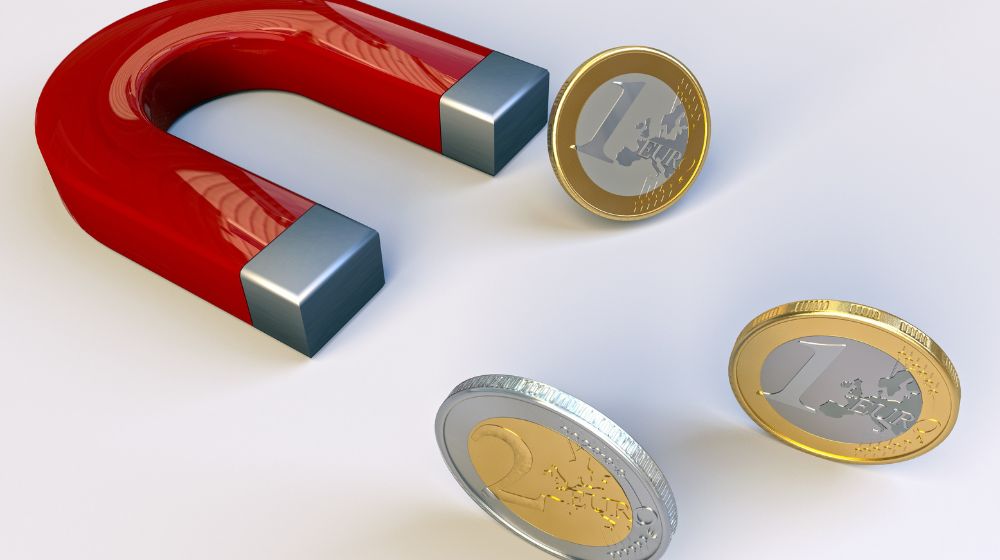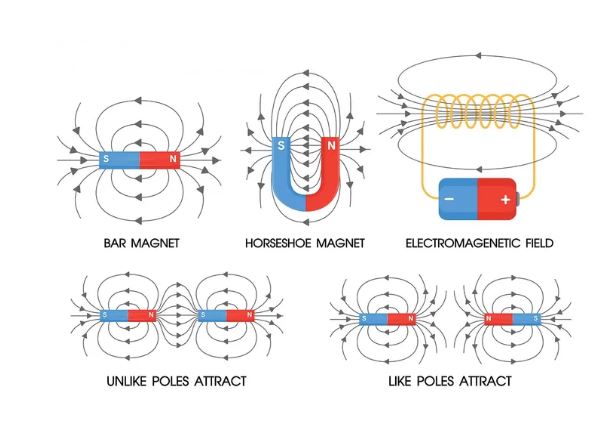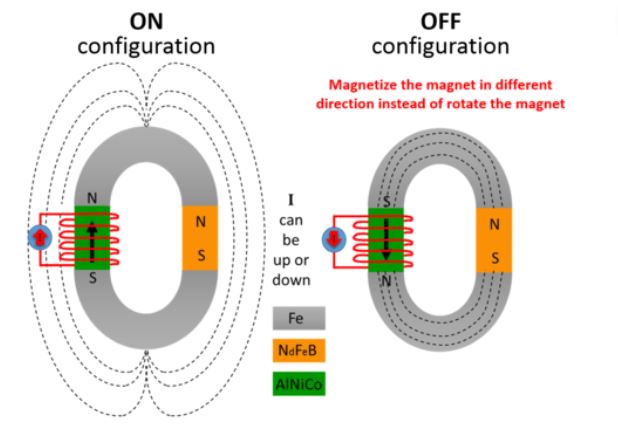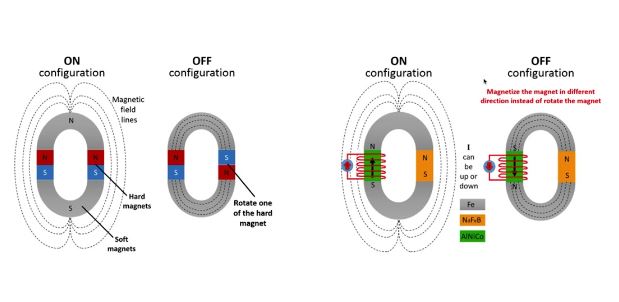Radial Magnets
Industry Application
Answers to Frequently Asked Questions
1. What is a Permanent Magnet?
A permanent magnet, also known as a permanent magnetic material or permanent magnet material, is a substance that retains its magnetic properties over an extended period, exhibiting a consistent magnetic field without the need for an exteal magnetic field. Permanent magnets are commonly used in various applications, such as in electric motors, generators, and magnetic storage devices.

2. How Permanent Magnets Work?
Permanent magnets work based on the alignment and stability of magnetic domains within the material. Magnetic domains are small regions in the material where atomic magnetic moments are aligned in a specific direction. In an unmagnetized state, these domains have random orientations, resulting in a net magnetic effect of zero.
When a material is magnetized, an exteal magnetic field aligns these domains in a preferred direction. In permanent magnets, such as those made from ferromagnetic materials like iron, nickel, or cobalt, the alignment of magnetic domains persists even after the exteal field is removed. This alignment creates a strong and consistent magnetic field within the material.
The key to the longevity of permanent magnets lies in the resistance of these aligned domains to randomizing influences. Factors such as temperature and mechanical shocks can affect the stability of permanent magnets, but their inherent structure allows them to maintain their magnetic properties over time, making them useful in a variety of technological applications.

3. What is an Electro-Permanent Magnet?
Often abbreviated as EPM, an electro-permanent magnet is a distinct magnetic object that relies on an electrical control system to tu on and off its magnetic state. The magnet exhibits numerous properties which are synonymous with electromagnets as well as permanent magnets. For a clearer understanding, here is a sneak peek of its working principles:

- Initial Magnetization
At the core of an electro-permanent magnet is a permanent magnet with robust magnetic capabilities. And just like a typical permanent magnet, this magnet contains specially aligned magnetic domains, which facilitate non-stop operation.
- Activation
Electro-permanent magnets are differentiated from permanent magnets by their distinct ability to activate or deactivate functionality. This is usually accomplished using an electrical pulse that tus off or on the magnet’s functioning. Activation occurs when the aligned magnetic domains are disrupted temporarily.
- Deactivation
This process is also referred to as neutralization and involves regulating the electrical pulse on the wire surrounding the permanent magnet. Permanent magnets, however, exhibit hysteresis behavior meaning that they can still demonstrate magnetic abilities despite the absence of electrical energy.
4. Advantages of Permanent Magnets
Permanent magnets offer several advantages in various applications due to their unique properties. Here are four key advantages:
- Stability of Magnetic Field
Permanent magnets maintain a stable magnetic field without the need for an exteal power source. This feature is crucial in applications like electric motors and generators, where a consistent magnetic field is required for efficient and continuous operation.
- Energy Efficiency
The use of permanent magnets in devices like electric motors contributes to energy efficiency. The stable magnetic field allows for reliable and efficient conversion of electrical energy into mechanical energy, reducing the overall energy consumption in various applications.
- Compact Design
Permanent magnets can be designed to be compact and lightweight while providing strong magnetic forces. This is particularly advantageous in applications where space is limited, such as in electronic devices, sensors, and medical equipment.
- Longevity and Durability
Permanent magnets exhibit a high resistance to demagnetization, ensuring their longevity and durability. They can withstand environmental factors, mechanical stress, and temperature variations, making them reliable for long-term use in different industrial and technological settings.
5. Disadvantages of Permanent Magnets
While permanent magnets offer various advantages, they also have some disadvantages that should be considered. Here are a few:
Cost
Certain materials used in permanent magnets, such as rare-earth elements like neodymium and samarium, can be expensive. The cost of manufacturing and processing these materials contributes to the overall expense of producing permanent magnets.
Limited Temperature Stability
Permanent magnets may experience a decrease in magnetic strength at elevated temperatures. High temperatures can lead to demagnetization, affecting their performance in applications where temperature stability is crucial.
Brittleness
Some permanent magnet materials, especially those made with rare-earth elements, can be brittle. This makes them susceptible to cracking or breaking under mechanical stress or impact, limiting their use in applications where durability is a primary conce.
Environmental Impact
The extraction and processing of certain rare-earth elements used in permanent magnets can have environmental consequences. The mining and refining processes may result in habitat disruption and chemical pollution if not managed responsibly.
Difficulty in Recycling
Recycling permanent magnets, especially those containing rare-earth elements, can be challenging due to the complexity of the materials involved. Developing efficient recycling methods is an ongoing challenge for minimizing the environmental impact of these magnets.
6. Electromagnet Vs Permanent Magnets
An electromagnet is a specialized device comprising magnetic material with an overlaying wire responsible for transmitting an electric pulse to magnetize the object. In contrast to permanent magnets, which retain functionality even without electricity, electromagnets have limited magnetism. Here, we examine these two distinct magnet types to enhance your understanding.

Electromagnets:
- Magnetic Field Generation:
Electromagnets generate an electromagnetic field by passing direct current through a magnetic core. This magnetic field can be easily activated or deactivated by switching the electric pulse on or off.
- Magnetic Strength Control:
The power of an electromagnet's electric field can be regulated by adjusting the current in the surrounding wire. Decreasing the electric pulse results in a weaker magnetic field, while increasing the current strengthens the field.
- Permanence:
Electromagnets depend on electric pulses to generate magnetic fields, making them suitable for temporary applications. They are not well-suited for permanent or energy-efficient applications.
- Energy Consumption:
Being energy-dependent, electromagnets require electric energy to function, leading to increased power bills.
Applications:
Due to their characteristics, electromagnets find use in applications such as electromagnetic brakes, solenoids, electric motors, and MRI machines.
Permanent Magnets:
- Magnetic Field Generation:
Permanent magnets utilize a natural magnetic field derived from the alignment of their magnetic spheres. This field cannot be tued on or off at will.
- Magnetic Strength Control:
The strength of permanent magnets is constant and determined by the construction material. They are challenging to modify after production, limiting their application fields.
- Permanence:
Permanent magnets are self-sufficient and require no exteal support to create a magnetic field. They are long-lasting and suitable for settings requiring constant and robust magnetic fields.
- Energy Consumption:
Permanent magnets create and retain a magnetic field independently, consuming minimal power. This makes them ideal for energy-intensive applications aiming to economize on energy use.
- Applications:
Permanent magnets are widely used in loudspeakers, generators, refrigerators, motors, and hard drives.
7. Differences Between Permanent and Temporary Magnets
| Characteristic | Permanent Magnets | Temporary Magnets |
|---|---|---|
| Magnetic Field Generation | Utilize natural magnetic field from aligned spheres | Generated by passing current through a magnetic core |
| Magnetic Strength Control | Largely constant, determined by construction material | Can be regulated by adjusting current in surrounding wire |
| Permanence | Self-sufficient, no need for exteal support | Depend on exteal influences, suitable for impermanent applications |
| Energy Consumption | Create and retain magnetic field independently | Energy-dependent, require electric energy for function |
| Applications | Used in loudspeakers, generators, motors, hard drives | Found in electromagnetic brakes, solenoids, temporary applications like lifting objects with magnetic force |
8. Types of Permanent Magnets
- Alnico Magnets:
Composed of aluminum, nickel, and cobalt.
Known for their strong magnetic field and high-temperature stability.
Commonly used in various industrial applications.
- Neodymium Iron Boron (NdFeB) Magnets:
Made from neodymium, iron, and boron.
Possess the highest magnetic energy of any commercial magnet.
Widely used in applications requiring strong and compact magnets, such as in electronics and electric motors.
- Samarium Cobalt (SmCo) Magnets:
Made from samarium, cobalt, and other rare-earth elements.
Exhibit high magnetic strength and temperature resistance.
Suitable for applications demanding stable magnetism at elevated temperatures.
- Ceramic or Ferrite Magnets:
Composed of iron oxide and other materials like barium or strontium.
Economical and widely used in various consumer and industrial applications.
Have good resistance to demagnetization.
- Flexible Magnets:
Made from a flexible, rubber-like material mixed with magnetic powder (usually strontium ferrite).
Can be bent, twisted, and cut into different shapes.
Commonly used in applications like refrigerator magnets, signage, and flexible magnetic sheets.
- Injection Molded Magnets:
Produced by mixing magnetic powders with a polymer binder.
Offer design flexibility and are suitable for complex shapes.
Widely used in automotive sensors, electric motors, and other precision applications.
9. What Shapes Do Permanent Magnets Have?
Permanent magnets come in various shapes to suit different applications and manufacturing requirements. Some common shapes of permanent magnets include:
Bar Magnets:
Rectangular or cylindrical in shape.
Often used in educational settings and basic experiments.
Horseshoe Magnets:
Resemble the shape of a horseshoe.
Concentrate the magnetic field between the poles, providing a strong magnetic force.
Ring Magnets:
Circular or donut-shaped.
Have applications in electric motors and generators.
Disk Magnets:
Flat and disk-like in shape.
Used in applications where a compact yet powerful magnet is required.
Cylinder Magnets:
Shaped like a cylinder or rod.
Commonly used in sensors, speakers, and various electronic devices.
Sphere Magnets:
Spherical in shape.
May be used in creative applications or educational demonstrations.
Cube Magnets:
Cubic in shape.
Provide a simple and uniform magnetic field and are used in various applications.
Custom Shapes:
Magnets can be manufactured in custom shapes to meet specific requirements.
This allows for flexibility in design and application.
The choice of magnet shape depends on factors such as the intended application, space constraints, and the desired magnetic field characteristics. Different shapes serve different purposes and are selected based on the unique requirements of the devices or systems they are incorporated into.
10. Characteristics of Permanent Magnets
Magnetic Strength:
Permanent magnets exhibit varying levels of magnetic strength depending on the material and manufacturing process.
Magnetic Stability:
They maintain their magnetic properties over time, resisting demagnetization.
Temperature Stability:
The magnetic properties of permanent magnets can be influenced by temperature, with some types being more stable at elevated temperatures than others.
Shape Variability:
Permanent magnets can be manufactured in various shapes, such as bar magnets, horseshoe magnets, and custom shapes, to suit different applications.
Durability:
They are durable and can withstand mechanical stress, making them suitable for a range of industrial applications.
Resistance to Demagnetization:
Permanent magnets resist losing their magnetic strength when exposed to exteal magnetic fields or physical impact.
Energy Efficiency:
In applications like electric motors, they contribute to energy efficiency by providing a constant magnetic field without the need for exteal power.
Versatility:
Permanent magnets find use in diverse applications, including electronics, automotive systems, medical devices, and industrial machinery.
Customization:
Manufacturers can customize permanent magnets to meet specific requirements in terms of size, shape, and magnetic properties.
Application Specific:
Different types of permanent magnets are tailored for specific applications, such as neodymium magnets for compact electronic devices or ferrite magnets for cost-effective solutions.
11. Factors That May Affect the Strength of a Permanent Magnet
Material Composition:
The type of magnetic material used in the magnet significantly affects its strength. Different materials, such as neodymium, samarium cobalt, and ferrite, offer varying magnetic properties.
Temperature:
Temperature changes can impact the strength of a permanent magnet. Some magnets may experience a decrease in strength at elevated temperatures, while others maintain their properties within a specific temperature range.
Exteal Magnetic Fields:
Exposure to strong exteal magnetic fields can affect the alignment of magnetic domains within the magnet, leading to a temporary reduction in strength.
Physical Impact:
Mechanical stress, such as dropping or hitting a magnet, can result in a decrease in magnetic strength. Brittle magnets, in particular, are more susceptible to damage.
Demagnetizing Factors:
Factors like high levels of vibration, strong electrical currents, or exposure to certain radiation can contribute to demagnetization and reduce the strength of the magnet.
Magnetization Process:
The method used to magnetize the material during manufacturing can impact the strength of the magnet. Proper magnetization techniques are crucial for achieving optimal strength.
Coating and Protection:
The coating or protective layer applied to the magnet's surface can influence its strength. A durable coating helps protect the magnet from corrosion and physical damage.
Manufacturing Quality:
The quality of the manufacturing process, including precision in shaping and magnetization, can affect the final strength of the magnet.
Ageing:
Over time, permanent magnets may undergo slight changes in their magnetic properties due to factors like corrosion or the aging of magnetic material. However, this change is usually gradual.
Magnetic Field Orientation:
The orientation of the magnet's magnetic field conceing its intended use can impact its effectiveness. Proper alignment is essential for achieving the desired strength in specific applications.
12. How to Make Permanent Magnets?
Making permanent magnets involves several processes, and the method depends on the type of magnet desired. Here is a general overview of how permanent magnets, particularly those made of neodymium or ferrite materials, are typically produced:
1. Material Selection:
Choose the appropriate magnetic material based on the desired properties. Common materials include neodymium iron boron (NdFeB), samarium cobalt (SmCo), or ferrite (ceramic).
2. Melting and Alloying (for NdFeB and SmCo):
For neodymium or samarium cobalt magnets, the process begins with melting and alloying the raw materials to form a homogeneous mixture.
3. Powder Production:
The alloyed material is then ground into a fine powder using specialized milling equipment.
4. Pressing:
The powdered material is pressed into the desired shape using a hydraulic press. This creates a green compact, which is a preformed shape of the magnet.
5. Sintering:
The green compact is subjected to high temperatures in a sintering fuace. This process fuses the particles together, creating a solid, dense magnet.
6. Machining:
After sintering, the magnet may undergo machining processes such as grinding or cutting to achieve the final shape and dimensions.
7. Magnetization:
The magnet is exposed to a strong exteal magnetic field during the magnetization process. This aligns the magnetic domains within the material, giving it its permanent magnet properties.
8. Coating (Optional):
Some magnets may undergo a coating process to protect against corrosion. Common coatings include nickel, zinc, or epoxy resin.
9. Quality Control:
The finished magnets undergo quality control checks to ensure they meet the specified magnetic and dimensional requirements.
It's important to note that the process can vary for different types of magnets, and additional steps may be involved based on the specific material and application. Additionally, the manufacturing of certain types of magnets, like ferrite magnets, involves different processes such as pressing and sintering the magnetic material directly without melting and alloying.
13. Applications of Permanent Magnets
Most of the time, we don't think about how important permanent magnets are, even though they are the most useful, unique, and useful tool we have. As they can draw metal to them and metal to them, they are very strong and very cool to use because of how they act. They can tu energy from machines into motion. Can make magnetic and electric fields, flux, and a lot more.
If we look at eclectic motors, we can see that they use the principle of magnetic action to move things. So there are a lot of other uses that are getting better every day because of how permanent magnets are getting better. If we look ahead, we can see that recent improvements in permanent magnets will show us the way.
14.Best Permanent Magnet Manufacturer-MAG SPRING®
Permanent magnets play a crucial role in our technological landscape, seamlessly integrating magnetism into our daily lives. This comprehensive guide serves as a reliable compass, offering valuable insights into the diverse world of permanent magnets. As we embark on an exploration of the magnetic wonders driving innovation and efficiency, whether you're a curious enthusiast or an industry professional, this intricate jouey reveals a magnetic tapestry shaping the present and holding promise for the future. For top-quality permanent magnets to enhance your machinery, consider reaching out to MAG SPRING®—a trusted company dedicated to providing reliable and high-performance magnetic solutions.

